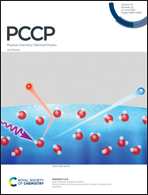Manipulating upconversion luminescence intensity in a single crystal particle with a waveguide structure†
Abstract
Lanthanide (Ln)-doped upconversion luminescence (UCL) materials have attracted worldwide attention due to their unique photophysical characteristics. However, how to effectively improve their UCL efficiency has always been an important scientific issue. Here, we design and fabricate β-NaYF4 microtubes (MTs) with a natural hexagonal shape in the cross section and wedge shape on both top vertexes, which can be regarded as an optical waveguide. The UCL property of a single β-NaYF4:Yb3+,Er3+(or Tm3+) MT is systematically investigated based on waveguide-excitation modes. It is found that the excitation light can be efficiently coupled in the β-NaYF4:Yb3+,Er3+(or Tm3+) MT by modulating the angle between the wedge-shape end plane of MT and the microscope slide. In addition, it is clearly observed that the excitation light can be confined and propagate in the MT by introducing a 633 nm laser, which is mainly due to the natural waveguide structure with a stronger confinement and propagation effect of light, thereby enhancing light-to-MT interactions. The current work provides a powerful solution to build high-efficiency Ln-doped UCL materials, which may have potential applications in the optical communication and biomedical fields.



 Please wait while we load your content...
Please wait while we load your content...